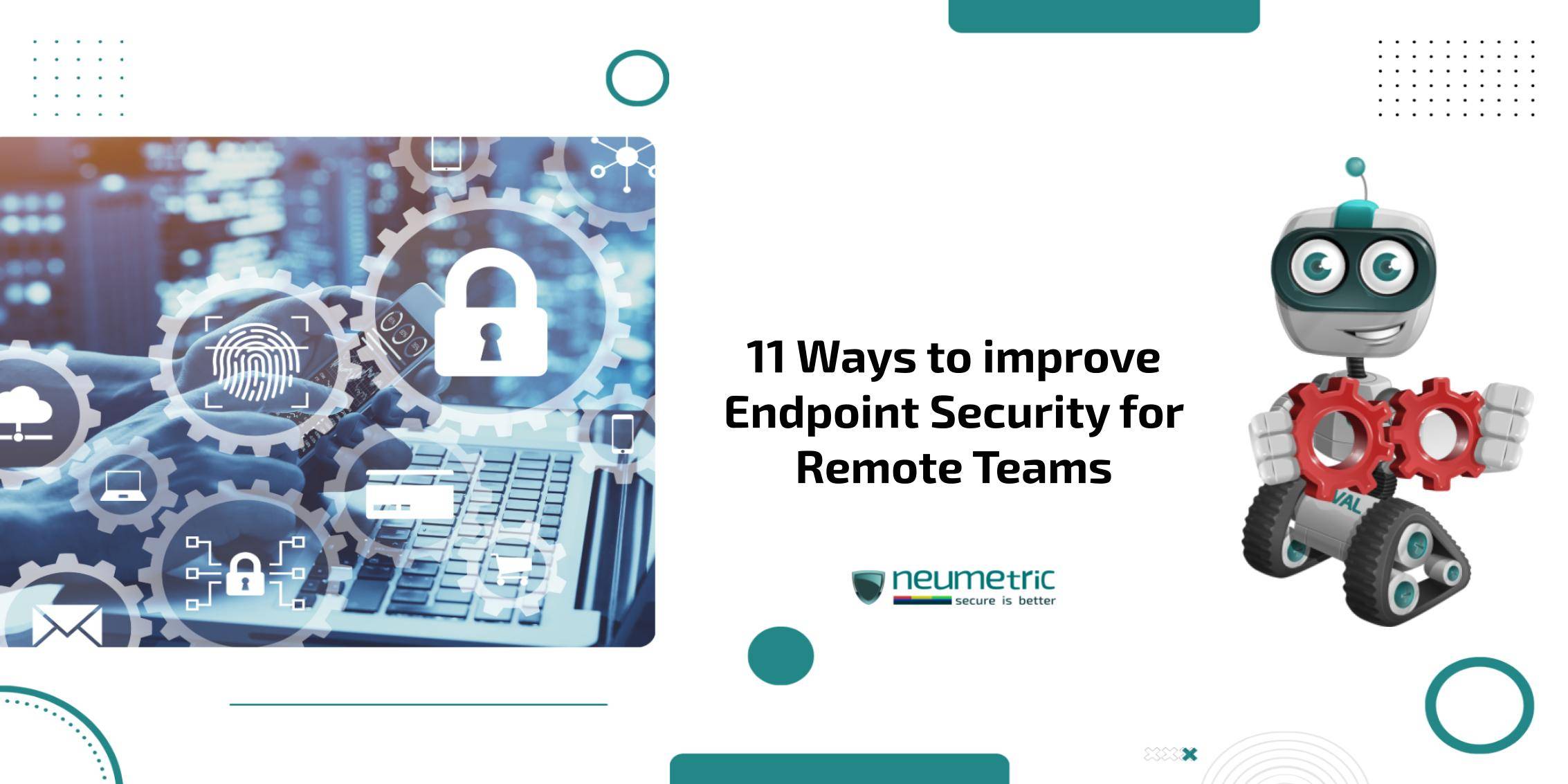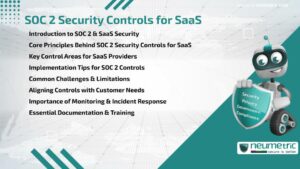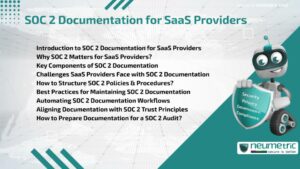Table of Contents
ToggleEndpoint Security Solutions for Remote Teams: 11 Ways to improve Endpoint Security
Introduction
The landscape of work has undergone a significant transformation with the rise of remote work. Technological advancements & shifting priorities have led to a surge in distributed teams, enabling professionals to work from anywhere. The freedom & flexibility associated with remote work have become integral aspects of modern work culture, creating a need for robust cybersecurity measures.
As remote work becomes a prevailing norm, the significance of endpoint security cannot be overstated. Endpoints, comprising individual devices used by remote workers, serve as the frontline of defense against cyber threats. Ensuring the security of these endpoints is paramount to safeguarding sensitive data, protecting against unauthorized access & maintaining the integrity of organizational networks.
Recognizing the critical role of endpoints in the remote work ecosystem, the purpose is to empower organizations & individuals with practical measures to mitigate risks. By understanding the current trends, acknowledging the importance of endpoint security & setting a clear purpose, readers can proactively fortify their remote work environments against evolving cyber threats.
Understanding Endpoint Security & Endpoint Security Solutions for Remote Teams
Endpoint security is a comprehensive approach to safeguarding the entry points or “endpoints” of a network. In the context of remote work, these endpoints encompass a wide array of devices, including computers, laptops & mobile devices. The definition extends beyond traditional antivirus measures, encompassing strategies to protect against unauthorized access, data breaches & other cyber threats.
Common Threats in Remote Work
In the realm of remote work, endpoints are particularly vulnerable to various threats. Common risks include phishing attacks, where malicious entities attempt to trick users into divulging sensitive information. Unsecured Wi-Fi networks pose another threat, potentially exposing devices to unauthorized access. Device theft is also a concern, as physical loss can lead to data breaches. Understanding these threats is pivotal for implementing targeted security measures.
Evolving Cyber Threats in Remote Environment
The landscape of cyber threats is in a constant state of evolution & remote work introduces its own set of challenges. Cybercriminals are deploying increasingly sophisticated malware & ransomware, taking advantage of the dispersed nature of remote teams. Social engineering tactics, such as pretexting & baiting, have become more refined. Staying informed about these evolving threats is imperative for organizations aiming to fortify their endpoint security. Regular updates & proactive measures are essential to mitigate the risks associated with the dynamic nature of cyber threats in a remote environment.
Assessing Current Security Measures
Evaluating Existing Protocols
To enhance endpoint security for remote teams, it is essential to begin with a thorough evaluation of existing security protocols. This involves a detailed examination of the policies & measures currently in place to protect endpoints. Assess the effectiveness of antivirus software, firewalls & any other security tools employed by the organization. Look into the comprehensiveness of these protocols & identify any areas that may require reinforcement or improvement.
Conducting Risk Assessment
Conducting a comprehensive risk assessment is a crucial step in understanding the potential threats & vulnerabilities faced by remote teams. Evaluate the types of data being handled, the devices in use & the communication channels utilized. Consider the impact of potential security breaches on sensitive information. By identifying & quantifying these risks, organizations can tailor their security measures to address specific threats effectively.
Identifying Vulnerabilities
Vulnerabilities in endpoint security can be present in various forms. These may include outdated software, weak access controls or unsecured communication channels. Actively seek out potential weaknesses in the existing security infrastructure. This involves analyzing system configurations, monitoring network traffic & assessing user access privileges. Identifying vulnerabilities is a proactive step toward fortifying endpoint security, ensuring a more resilient defense against potential cyber threats.
Implementing Multi-Factor Authentication [MFA]
MFA Concept & Benefits
Multi-Factor Authentication [MFA] is a security mechanism that adds an extra layer of protection beyond traditional username & password combinations. The concept involves requiring users to provide multiple forms of identification before granting access, significantly strengthening the security posture. Benefits of MFA include heightened protection against unauthorized access, reduced risks of phishing attacks & enhanced overall cybersecurity. Exploring these concepts helps organizations understand the fundamental principles & advantages of implementing MFA for remote teams.
Step-by-Step MFA Implementation
- Assessment: Begin by evaluating the existing authentication process & identifying potential weak points.
- Select Authentication Methods: Choose appropriate factors for multi-factor authentication, such as passwords, PINs, fingerprint scans or mobile app verification.
- Integration with Systems: Integrate MFA seamlessly into existing systems, ensuring compatibility with various platforms & applications used by remote teams.
- Configuration: Configure MFA settings based on the chosen authentication methods, specifying when & how users will be prompted to provide additional verification.
- User Education: Educate users about the new MFA measures, providing clear instructions on how to set up & use the authentication methods.
- Testing: Conduct thorough testing to identify any potential issues & ensure a smooth implementation process.
- Rollout: Gradually roll out MFA across the organization, monitoring the implementation to address any challenges that may arise.
Software Updates & Patch Management
Importance of Keeping Software Updated
Regularly updating software is crucial for maintaining a secure endpoint environment. Keeping software up-to-date is not merely about accessing new features but is a fundamental practice to address security vulnerabilities. Updates often include patches that close known security loopholes, reducing the risk of exploitation by cyber threats. By prioritizing software updates, organizations can ensure that their remote teams operate on the latest, most secure versions.
Risks of Outdated Software
The use of outdated software poses significant risks to endpoint security. Unsupported & unpatched applications & operating systems become prime targets for cybercriminals. Vulnerabilities in outdated software can be exploited, leading to unauthorized access, data breaches & potential system compromises. Understanding these risks underscores the urgency of maintaining up-to-date software to mitigate potential security threats effectively.
Proactive Patch Management
A proactive approach to patch management is essential for minimizing security risks in a remote work environment. This subsection guides organizations in establishing a robust patch management strategy. This includes conducting regular vulnerability assessments to identify potential weaknesses, prioritizing critical patches for immediate deployment & implementing a systematic testing process to ensure patch compatibility. Proactive patch management not only reduces the organization’s exposure to vulnerabilities but also enhances the efficiency of remote teams by maintaining a secure & reliable digital infrastructure.
Employee Training & Awareness
Educating Teams on Security
In the ever-evolving landscape of cybersecurity, empowering remote teams with the knowledge to recognize & mitigate potential threats is paramount. Educating teams on security involves fostering a deep understanding of best practices. This includes recognizing common phishing attempts, adhering to secure communication protocols & understanding the implications of their actions on overall security. By instilling a culture of vigilance & responsibility, organizations can strengthen their defense against potential endpoint security threats.
Creating a Training Program
Establishing a comprehensive training program is essential for equipping remote teams with the skills & knowledge needed to navigate the digital landscape securely. The training program should cover cybersecurity fundamentals, secure communication practices & guidelines for handling sensitive information. Additionally, incorporating simulated phishing exercises & real-world scenarios enhances the effectiveness of the program, allowing employees to practice their newfound knowledge in a controlled environment. A well-crafted training initiative ensures that every team member becomes an active participant in maintaining the security of remote endpoints.
Updating Teams on Emerging Threats
Endpoint security is an ongoing commitment, requiring teams to stay informed about emerging threats. Regular updates on the latest cybersecurity trends, tactics employed by cybercriminals & precautionary measures are essential. By providing continuous education on emerging threats, organizations enable their teams to stay vigilant & adapt their security practices accordingly. This proactive approach ensures that remote teams are well-prepared to face the evolving challenges posed by cyber threats.
Endpoint Encryption Best Practices
Role of Encryption in Endpoint Security
Encryption serves as a cornerstone in the defense against unauthorized access & data breaches. This subsection delves into the fundamental role of encryption in endpoint security. It highlights how encryption safeguards sensitive data on remote devices, whether it’s stored locally or transmitted over networks. Understanding the principles of encryption is crucial for appreciating its significance in maintaining the confidentiality & integrity of data.
Implementing Encryption
Practical implementation is key to realizing the benefits of encryption. This section provides a step-by-step guide for organizations to effectively implement encryption for remote endpoints. It covers encrypting file systems, securing communication channels & implementing encryption for email communications. By following these implementation steps, organizations can ensure that data on remote devices remains confidential & protected against potential security breaches.
Selecting Encryption Tools
Choosing the right encryption tools is a critical aspect of a successful endpoint security strategy. This part guides organizations in selecting suitable encryption tools based on factors such as ease of use, compatibility with existing systems & the strength of encryption algorithms. A careful selection process ensures that the chosen encryption tools align with the organization’s specific needs, providing a robust defense against potential security threats.
Secure VPN Usage
VPNs for Secure Remote Connections
In the realm of remote work, Virtual Private Networks [VPNs] play a pivotal role in ensuring secure & encrypted connections. This subsection explores the significance of VPNs for remote teams, elucidating how they create a private & secure communication channel over the internet. It delves into the encryption protocols employed by VPNs & their role in safeguarding sensitive data during transmission. Understanding the capabilities of VPNs is crucial for organizations aiming to establish a secure remote work environment.
Choosing a Reliable VPN
Selecting a reliable VPN is a critical decision in fortifying endpoint security for remote teams. This section provides a comprehensive guide on factors to consider when choosing a VPN service. It covers aspects such as encryption strength, logging policies, server locations & user-friendly interfaces. By navigating through these considerations, organizations can make informed decisions to ensure they opt for a VPN service that aligns with their security requirements.
Proper VPN Configurations
Effectively configuring VPN settings is essential to maximize security & privacy benefits. This subsection offers a step-by-step guide on the proper configuration of VPNs for secure remote connections. It covers aspects such as choosing the right VPN protocol, setting up kill switches & configuring split tunneling. Proper VPN configurations ensure that remote teams can enjoy the benefits of secure connections without compromising on performance or inadvertently exposing sensitive information. This part empowers organizations to implement VPNs effectively as part of their comprehensive endpoint security strategy.
Device Management & Control
Policies for Authorized Devices
Establishing clear policies for authorized devices is a fundamental step in maintaining control over endpoint security for remote teams. This subsection explores the importance of defining which devices are permitted to access organizational resources. It outlines considerations for creating device policies, such as device type, operating systems & security features. By setting strict guidelines, organizations can ensure that only trusted & secure devices connect to their networks, minimizing the risk of unauthorized access.
Remote Device Management Solutions
Implementing robust remote device management solutions is essential for maintaining control & security over a distributed network of devices. This section provides insights into selecting & deploying effective device management tools. It discusses features such as remote device tracking, patch management & configuration control. By leveraging these solutions, organizations can streamline device management processes, proactively address vulnerabilities & enforce security policies across the remote workforce.
Enforcing Access Controls
Enforcing access controls is a critical aspect of device management & control. This subsection details strategies for ensuring that only authorized individuals can access sensitive information & resources. It covers techniques such as role-based access controls [RBAC], strong authentication methods & regular access audits. By consistently enforcing access controls, organizations can minimize the risk of unauthorized access, data breaches & other security incidents, ensuring a higher level of endpoint security for remote teams.
Incident Response Planning
Developing an Incident Response Plan
Developing an incident response plan is a proactive measure to minimize the impact of security incidents. This subsection emphasizes the importance of creating a comprehensive plan that outlines the steps to be taken in the event of a security breach. It discusses key components, including incident identification, reporting procedures & designated response teams. A well-crafted incident response plan serves as a roadmap for effectively mitigating & recovering from security incidents.
Quick Detection & Response
Quick detection & response are critical elements of an effective incident response strategy.Rapid detection & response minimize the potential damage caused by security incidents, limiting their impact on remote teams & organizational assets.
Testing & Updating the Plan
Testing & updating the incident response plan are ongoing activities that ensure its effectiveness in real-world scenarios. Regular testing & updates enhance the agility & responsiveness of the incident response plan, ensuring it remains a robust & reliable tool for addressing security incidents.
Collaboration with Endpoint Security Experts
In the complex landscape of endpoint security, seeking professional advice is a strategic move for organizations aiming to fortify their defenses. Seeking professional advice ensures that organizations receive up-to-date & specialized insights to enhance their endpoint security measures.
Engaging cybersecurity experts is a proactive step toward addressing the dynamic & evolving nature of cyber threats. By fostering collaborations with experts, organizations can leverage specialized knowledge, access advanced tools & benefit from ongoing support to continuously improve their endpoint security posture.
Conclusion
In conclusion, there is a strong emphasis on the proactive approach organizations should adopt to mitigate potential risks. Encouraging a proactive stance involves staying ahead of potential threats, anticipating vulnerabilities & implementing preemptive measures. By doing so, organizations can not only enhance their security posture but also create a culture of resilience in the face of evolving cyber threats.
In concluding the exploration of enhancing endpoint security for remote teams, it’s essential to recap the key insights provided throughout. The journal summarizes the fundamental strategies discussed, including multi-factor authentication, software updates, employee training, encryption best practices, VPN usage, device management & collaboration with security experts. Reinforcing these key points serves as a quick reference for readers, highlighting the crucial elements of a robust endpoint security strategy.
Endpoint security demands persistent commitment rather than a one-time endeavor. There is a necessity of continuous vigilance & adaptation to the evolving threat landscape. Emphasizing the importance of regularly assessing & updating security measures to address emerging challenges & vulnerabilities is beneficial for the organization. By highlighting the dynamic nature of cybersecurity, organizations are encouraged to embrace a proactive & continuous improvement mindset in safeguarding remote endpoints.
Frequently Asked Questions [FAQ]
Why is multi-factor authentication [MFA] crucial for remote teams’ endpoint security?
MFA adds an extra layer of protection, requiring multiple forms of identification. This minimizes the risk of unauthorized access, a common threat in remote work scenarios.
How can I ensure my team stays updated on emerging cyber threats?
Regularly subscribe to industry publications, participate in webinars & attend conferences to stay informed. Ongoing awareness is key to adapting to the ever-evolving threat landscape.
Why is encryption important in endpoint security & how do I implement it effectively?
Encryption safeguards sensitive data on remote devices. Implement it by following a step-by-step guide, ensuring file systems, communication channels & email communications are all appropriately encrypted.





